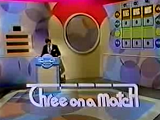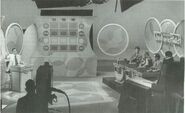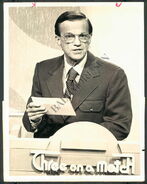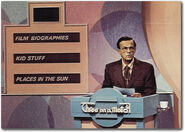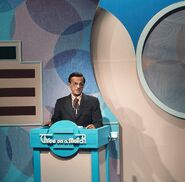| Aired | |
| NBC daytime, August 2, 1971 - June 28, 1974 | |
| Run time | |
| 30 Minutes | |
| Host | |
| Bill Cullen | |
| Announcer | |
| Don Pardo, Bob Clayton, Roger Tuttle, Wayne Howell | |
| Origination | |
| NBC Studio 6A, New York City, New York | |
Game Format[]
Three contestants competed to determine who could answer the most true-or-false questions in one of three categories. After Cullen announced the categories, each contestant bid a number between one and four based on how many questions he or she desired to answer on that turn.
A player could win the bidding in two ways: either by having the highest bid or by having his or her opponents bid the same number, which canceled out their bids. If all three players chose the same number, another round of bidding was conducted to break the deadlock. If that failed, the categories were discarded in favor of new ones, and the process began again. The pot for the round was calculated by totaling the number of questions bid by all three contestants and then multiplying by $10 (for example: 4, 3, and 2 totals 9, which becomes $90), making for a maximum possible pot of $110.
When one contestant won the right to answer questions he/she selected one of the categories. If a contestant failed to correctly answer as many questions as he/she bid, control passed to the next highest bidder, then the lowest bidder if the second player was unsuccessful. If the two contestants matched bids and canceled each other out, and the remaining contestant failed to fulfill his/her bid, the canceled players were given a chance to re-bid, with the higher bidder having a chance to answer questions from the two remaining categories. If they canceled each other out again, the game moved on to a new set of categories. When a contestant fulfilled the bid, the contestant won the pot.
Some categories had a special feature hidden behind them, which was revealed when it was selected. The most frequent was "Double Pot" which doubled the value of the pot the contestant was playing for (up to $220). Another offered "One Free Box", "Two Free Boxes", or "Three Free Boxes", which gave the contestant extra free selections on the game board. However, the contestant could only take the free boxes after buying as many boxes as possible with his/her money.
After winning a pot, the contestant kept the money and continued playing, or could use the accumulated money to try to win the game at the bonus board. If the contestant won any free boxes in the previous round, they had to be used immediately after winning them, or the free boxes were forfeited. The minimum amount required in a contestant's bank to play the board was $90, unless the contestant had earned free boxes during that category.
Prize Board[]
The board consisted of three columns boxes: the first worth $20, the second worth $30, and the third worth $40. Each column had four rows of boxes in colored rows (red, green, yellow, and blue). Originally, each box concealed a prize. Three prizes appeared in each column, and two (or three) others appeared in some columns but not others. One box on the board contained a "No Match" sign.
The contestant used his/her money to spend on the boxes in an effort to reveal three matching prizes, one in each column. A contestant selected a box using a phrasing specific to the program, such as "I'll take $20 on the blue", and continued until revealing three identical prize cards (winning the game), or until running out of money and free boxes before matching a prize. If a contestant did not match a prize, the game continued with more question rounds. Additionally, when selecting boxes, contestants could only select three out of the four boxes in any one column.
A contestant who made a match on his/her first three picks after winning a question series won a new car in addition to whatever prize was matched.
Any champion who won five consecutive matches retired undefeated and received an additional $5,000.
Format changes[]
On April 23, 1973 the prizes on the bonus board were replaced with images (e.g., slot machine symbols, celebrity faces, or even humorously altered photos of Cullen). A player who matched three symbols won that match, and the first player to win three matches—or to get an instant match—won the game and a prize package worth at least $5,000.
An additional game, called "The Big Match", was also occasionally played (usually at the episode's midpoint, interrupting the regular game) and offered contestants the chance to win a cash prize by matching two halves of a bill hidden among the 12 boxes. In turn, the contestants called out a box hoping to find one half of the bill. Gameplay continued until either nine blank boxes were revealed (ending the round) or until one player found one half of the bill. That player was given one additional choice of the remaining boxes in order to find the second half, winning $1,000 if he/she was successful. For each fifth game the money went unclaimed, an additional $1,000 was added to the jackpot.
Another bonus was later added awarding $5,000 in cash and a new car to any player who made seven consecutive matches at the board. In addition, champions were no longer retired and continued to play so long as they continued to win matches.
Other bonuses and features were added and removed throughout the run. During the second format, home viewers were invited to send in postcard entries for theme-writing contests. The three funniest entries won prizes.
Also during the second format, a symbol (such as a heart) would appear on the board in every game during certain special weeks regardless of whether it fit the category. Each contestant who matched the symbols would be entered into a drawing for a special prize at the end of that week.
| This page uses Creative Commons Licensed content from Wikipedia (view authors). |
Trivia[]
One contestant, named Fred Abrams, managed to reach seven consecutive matches & an Instant Match at the same time, earning $5,000 in prizes, $5,000 in cash, and a new car for that one game, and a grand total of over $35,000.
International Versions[]
Main Article: Three on a Match/International
Merchandise[]
Milton Bradley made only one edition in 1972, which followed the first Prize Board round.
Photos[]
Press []
Ticket[]
Episode Status[]
Video[]

Three On a Match (December 17, 1973)

Three on a Match (February 11, 1974)
